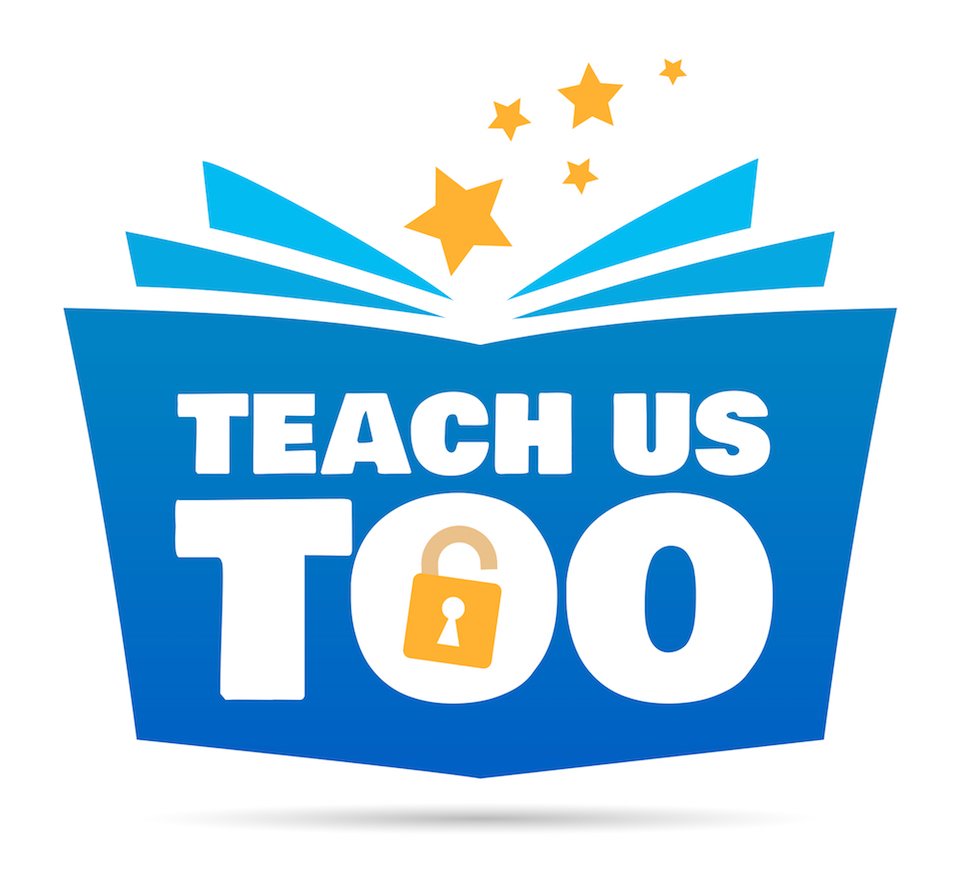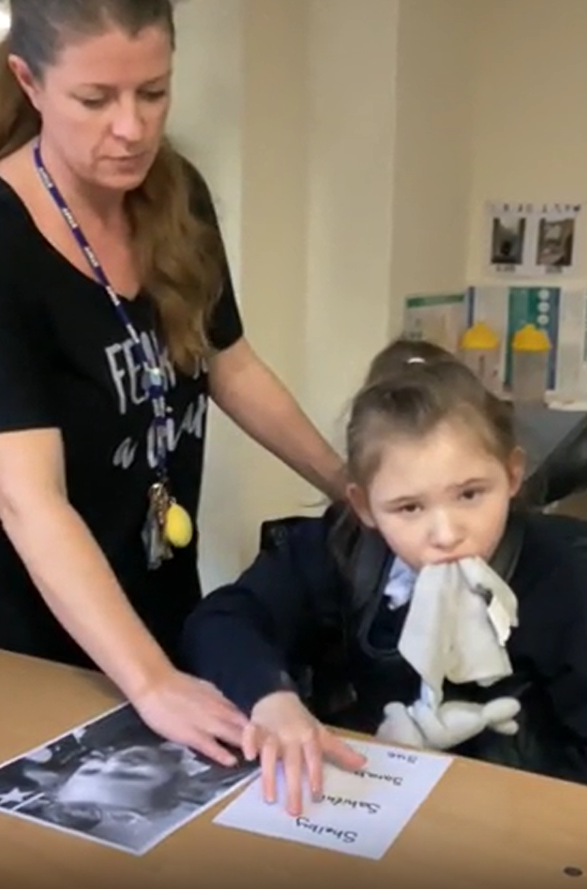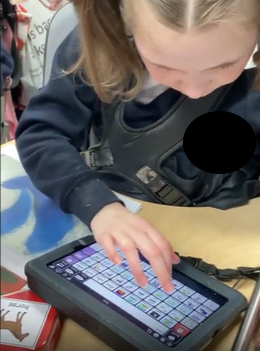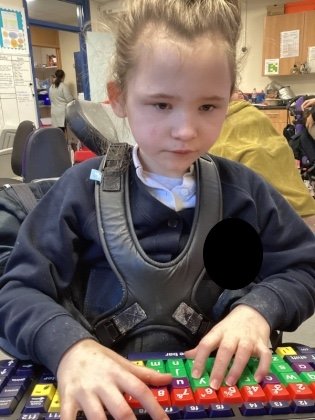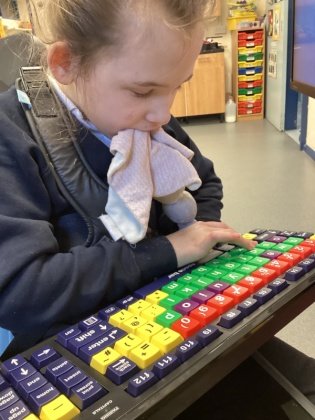Shelby’s Story
A guest blog post by
Virginia, Class Teacher (Special Education School)
I started teaching Shelby two years ago, she was 9 years old and was well-known for her behaviours: screaming, self-harming, attacking others, self-stimulating, refusing to be hoisted, holding her bowel movements, refusing to eat or drink, controlling her environments, sleeping all day. She is undiagnosed, but clearly on the autism spectrum, is non-verbal and a wheelchair user - yet is not in a self-propelled wheelchair, although could easily use one.
I have always been a big advocate for communication and ensure that all the students I teach are taught a form of communication that is accessible to them, so I was very keen to work with Shelby who I’d heard about through staff members. Our feeling was that she had a lot to say and no way of saying it so would lash out at herself and others as a form of controlling her environment and communicating her frustration at the world.
At first we tried large symbols, switches and various talking aids. She was clearly more advanced than these aids could offer. I was told speech and language had tried this previously but, because she repeated herself continuously, they were removed.
She quickly got bored of the small selection I gave her so I worked with SaLT to make her a communication book. It was quite big and complex and, although she was unable to make sentences, she quickly picked up on the symbol’s meanings and would point to a symbol to communicate what she wanted - starting with snacks. Through this we also discovered she could count and knew her numbers to 10, being able to add or subtract one.
She quickly got bored of her book and it was apparent to me that this was due to the fact that people didn’t always see her pointing to a symbol, I felt she needed technology and a voice output to get people’s attention, as she instead resorted to screaming and then would get the attention she was looking for. I was told she didn’t meet the criteria for a VOCA as we couldn’t prove that she was able to use low tec in a way that ticked the proverbial boxes of commenting.
During this time she was increasing her want to affect her environment and would get very frustrated in the sensory room when she didn’t have control over every aspect. For example, she would shout if the door was left open or the lights were left on and then would get very angry by the choice of music played on the stereo, rolling or crawling to bite, scratch or pinch staff or students.
Eventually, a staff member went over with the CD box and placed it beside her. She commando-crawled to it, found the CD she wanted, pulled it out and, once the insert was removed and shown to her, she pointed to a song. The TA then put that song on and she instantly calmed down and seemed to start singing along. This told us that she could read! I decided we no longer needed to spend ages every morning printing off an individual symbol timetable that was hard to deviate from, and I asked the team to write her routine down to show her as we greeted her every morning from the car. This seemed to help her anxieties and we noticed she was pointing to the lessons or activities she was looking forward to such as snack, lunch and home time.
I then found out about a free communication app for iPads where you can add a voice for £50 called 'snap app' by Tobii Dynavox. I spoke to her social worker and managed to get the £50 funding and we used a class iPad for this. She instantly took to it and started to babble. Repeating words, sounds and phrases over and over. We responded and tried to model on the machine how to structure a sentence or find a word with meaning in context. This then gave us the evidence SaLT needed to get the funding for her own VOCA.
Last summer she received this and she is now learning how to communicate with the symbolised cells but she often navigates to the qwerty keyboard and types random letters, especially WWWW, as if she is looking for a website.
With a recent big push for teaching phonics in our school, I have struggled to understand how to go back to basics with her when it seems that she already has the ability to sight read.
Recently, I decided to take her lead and we have purchased a Bluetooth, child’s keyboard and, with music as her current motivation, I’m trying to show her how to type the songs she requests into YouTube on the class whiteboard.
Every day we have time set aside for ‘jukebox’ where the students select a song they would like to listen to. I’ve added these to her VOCA, and now, when she asks for them, I produce her keyboard and help her with hand over hand, to type in the names of the songs she is requesting while I speak out each letter name and sound. As I do this, she seems to engage with it well and likes it a lot as she gets the reward of her song at the end.
I also now print out any activity we are doing and give her a copy as if she were an adult. A team member noticed during choir one day that she would take the word sheets from the adults and follow the lyrics with her finger at the right moments. So, now I print everything off! I give her a physical copy of our sensory stories, our story massage or movement to music song lists and my next step is to print off the lyrics to the songs that we listen to in jukebox and see if she is wanting to trace the words as the songs are played, as she does in choir, to expose her to print as much as possible.
As a result of all of this along with the many therapeutic interventions we’ve tried, Shelby rarely hurts anyone, she no longer pinches herself and only occasionally bits her wrists. She’s not sleeping in class every day or self stimulating and allows other people into her space. She’s even coping with her mum and siblings coming into school and will let us hoist her. She’s eating a wider range of food at school which is helping her bowels to open more regularly and she’s allowing us to do massages and exercises to move her bowels when they’re slowing down.
She chats all day, mostly requesting but occasionally commenting on her environment and what others say or do. We’ve seen such a wicked personality - she’s even tried to type swear words on her voca before - and was very proud of it too!
Shelby's mum, Sonia, asked me to add this:
Myself and Shelby's siblings have always included her in everything that we do whether it's listening to music or reading and watching the TV.
We started giving Shelby the argos book to look through and Shelby used to enjoy looking at the pictures mainly the toys first which was great as it gave me ideas for her birthday/Christmas. If Shelby couldn't find the argos book she would go looking for it.
Attending appointments I would find magazines for her to look through and talk through what she was looking through.
if anyone of us brought some new music we would give Shelby the case so she can study the pictures and also the words to the songs and then Shelby would find that artist on her tablet.
If Shelby watches the TV you can bet that she finds ads and programmes on her tablet.
Shelby used to like taking videos of things and people and watching it back over and over again.
Every day I talk to Shelby about the weather and what day it is.
